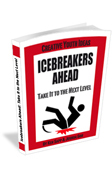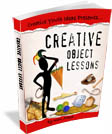1. Add Social Time
Start your meetings ten minutes earlier than usual with a fun icebreaker*!
2. Keep It Moving
Change gears every twenty minutes – Every 20 minutes change something! Activity, presentation style, take a break, change the sitting arrangement, change partners or groups, have a team presentations, exercise, game, quiz, etc. You can even throw a related icebreaker* in the middle of the meeting as an attention getter! Just make sure everything ties together!
3. Creative Reflections
After your lesson, break the youth into groups of 5 to 8 people and challenge each small group to perform a creative expression of the lesson as a skit, a song, a rap, a dance, etc. recap part of the “learnings” from the session. You can also use a related icebreaker* to close a session if it reinforces the theme.
4. Change Places
Place the names of the youth and teachers attending the meeting in a bowl. Then, everyone draws a name other than their own. When responding to ideas, youth anonymously assume the persona of the person on their card and respond from their (assumed) point of view. Later they can try to guess who was playing who!
5. Give Them A Chance!
Have soft kids’ toys in the room (foam balls, squish toys, etc.) Any time someone crushes another person’s idea (e.g., “that won’t work…we tried that before…it’ll cost too much…” etc.), or says something negative or discouraging, group members are invited to pick up the nearest soft toy and bombard the offender, shouting “Give Them A Chance!”
6. Countdown
Got some people who dominate the discussion? Get a three minute egg timer (miniature hourglass) or electronic alarm clock and use it to time discussions. When the agreed-upon time is up, the timekeeper shouts out “Time!” which is the signal to move on.
7. Call an expert!
During a break, group members call someone (another youth not present in the meeting, a parent, a teacher, a youth worker, etc and get another perspective or insight on a key question! Everyone then reports back to the group!
8. Balloon Toss
Youth must write ideas to a given challenge on a small piece of paper (one per sheet), fold the paper up and put it inside a balloon. The must then blow up balloons, and tie them. Everyone tosses the balloons around for 15-30 seconds (high energy break), and then captures a balloon. Each person takes the new idea or answer they have received, and builds on it and report to the group.
9. Games
Add a game to the lesson or include a game in the middle that teaches an important truth or application related to the lesson… Make your point then continue with the lesson! During breaks, stage games or competitions that challenge people mentally or physically. If energy is lagging, use games that involve some physical activity.
10. Celebrate Success
Award Blue Ribbons, sweets or other treat for good answers, for contributing to discussions, and for being actively involved and participating!
11. Lighten Up!
Ask the youth to identify the most common types of disruptive behaviors in meetings (interrupters, boors, manipulators, side conversations, nay-sayers, etc.) Anytime someone reflects one of these behaviors, any member (or the whole group) can shout out “I Don’t Think So!” to lightly remind the “offender.”
12. Exercise Break
Rotate responsibility for group members to lead the group in some kind of physical exercise to start the meeting or use during breaks. If desired, award prizes for the best exercises of the week/month. Bring a boom box with upbeat music to accompany.
13. Think Outside the Box
Wear something unusual! Change the meeting location, decor, seating arrangement, dress code, lesson style, or another common feature to something unusual.
14. Thinking Caps
Create hats for different roles in the group… from time to time change hats… Doubter, debater, champion, questioner, Mr Practicality, what if?, Just the facts, gut reaction, What I feel, Optimist, pessimist, creativity, off the wall, Pastor’s perspective, Parent’s perspective, etc. Members must respond from the perspective of the person represented by the hat. You can even use Biblical characters! Save the hats for future meetings, but don’t use them every week! Make them wild, fun and silly.
*Need help for creative icebreakers to add excitement plus a message to your meetings?
Check out “Icebreakers Ahead: Take it to the Next Level!” by Ken Sapp
Visit www.creativeicebreakers.com
 Icebreakers Ahead: Take It To the Next Level
Icebreakers Ahead: Take It To the Next Level
This 170 page resource not only provides 52 of the world’s most popular group icebreaker activities and games, but also includes lesson ideas and discussion questions to smoothly transition into conversations about the issues common to most groups.
Click here to find out how to get your hands on this incredible resource!


